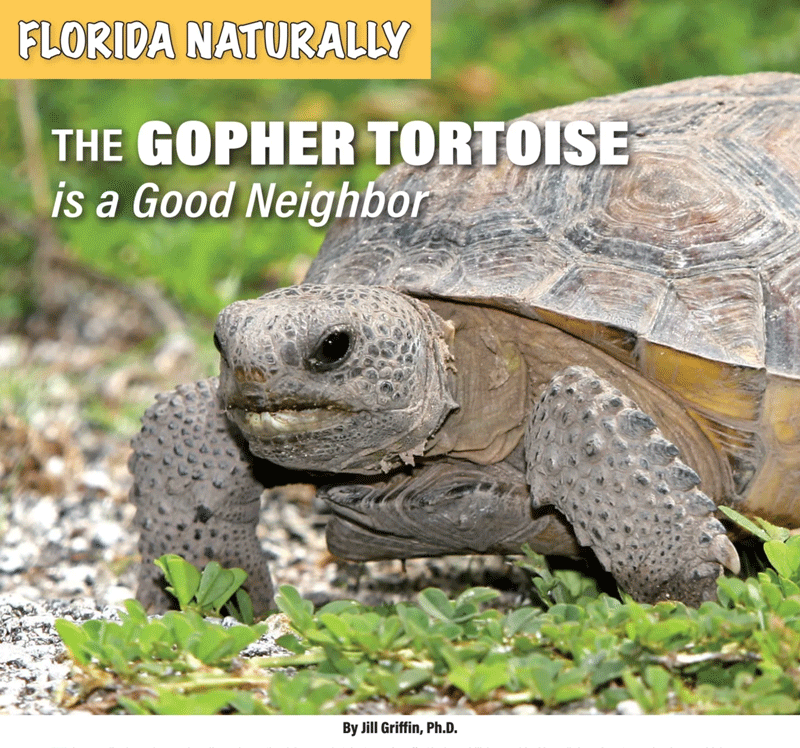The Gopher Tortoise is a Good Neighbor
Printed in Hobe Sound Magazine, May 2024
By Jill Griffin, Ph.D., Executive Director, Hobe Sound Nature Center
(in cooperation with the Nathaniel P. Reed Hobe Sound National Wildlife Refuge)
Take a walk along the scrub trails at the Nathaniel P. Reed Hobe Sound National Wildlife Refuge, and you’re sure to spot one of nature’s most ancient creatures – the state-threatened gopher tortoise. You may be wondering how a reptile was named after a mammal that, well, resembles a furry potato. The gopher is a burrowing rodent that creates incredibly well-thought-out and complex burrow systems, complete with food storage rooms, nurseries for their babies, and rooms for resting and recreation. Though the gopher tortoise isn’t quite the equal homemaker, they dig many, expansive burrows each year that can reach 40 feet in length! They use their powerful, shovel-like front feet to dig and their elephantine back feet to stabilize themselves. The burrows help gopher tortoises stay warm in the winter and cool in the summer, while also protecting them from drought, fire, and predators. And, like a good neighbor, gopher tortoises graciously share their burrows with over 350 other species, including the eastern indigo snake, the gopher frog, burrowing owls, the Florida mouse, and hundreds of other rodents and invertebrates. This neighborly love has awarded the gopher tortoise the title of “keystone species”. In architecture, the keystone is the wedge-shaped stone that is positioned last at the top of an arch, effectively stabilizing and locking all the other stones in place. In biology, a keystone species is critical to the survival of other species and the stability of the ecosystem it inhabits.
Gopher tortoises are most active during mating season, which spans from March to September. Males roam around looking for receptive females, occasionally trying to entice their dates with lengthy head-bobbing courtship displays. Males take this job very seriously and are known to fight each other at the entrance of a reproductive female’s burrow by ramming, pushing, biting, and trying to flip each other over. If the female isn’t impressed, she will give the courting male the cold shoulder and promptly block the entrance to her burrow. There is no shortage of drama in the animal kingdom!
Gopher tortoises are reliant on scrub habitats, which are characterized by sandy, well-drained soil and scattered shrubs. Their burrows are also protected, which acts as a conservation “umbrella” for rapidly disappearing scrub land in Florida, and habitat loss is the greatest threat to gopher tortoise populations. As the highly desirable, elevated, dry land is developed, our official state tortoise often finds itself fighting a losing battle.
Gopher tortoises are protected by state law, which means people are prohibited from harassing, disturbing, or killing gopher tortoises or destroying their eggs and burrows. When an area is being proposed for development, FWC requires a permit to coordinate the relocation of all gopher tortoises before clearing and construction begin. If you discover a gopher tortoise burrow on your property, do your best to minimize disturbance to the burrow and avoid mowing near the entrance. Though it’s illegal to handle a gopher tortoise, FWC does allow citizens to help a tortoise attempting to cross a road by gently and carefully moving them out of harm’s way, in the direction it was heading. If you come across a sick or injured gopher tortoise, please call (850)921-1030 on weekdays from 8 am to 5 pm and FWC’s Wildlife Alert hotline after hours and on weekends: (888)404-3922 or download the FWC Wildlife Alert app on Google Play or the Apple Store.
The gopher tortoise is more than just another species in Florida's diverse wildlife tapestry; it is a cornerstone of the ecological framework. Protecting this venerable creature is not just an act of conservation; it is an investment in the health and stability of entire ecosystems. By understanding the challenges faced by the gopher tortoise and taking action to mitigate them, we can ensure that Florida's scrub habitats, and this unique, ancient creature, remain vibrant and diverse for generations to come.

